Views: 9
This article was originally found on Mental Floss.
Before Spanish colonizers arrived in the Mississippi River valley in the 16th century, Native peoples built huge cities, developed extensive river-based trade routes, and constructed extraordinary earthworks. These mounds take different forms—low and round, tall and conical, broad and flat-topped, even animal-shaped—and served as important ceremonial and burial sites for hundreds of years or more. Here are 11 ancient Native American earthworks that offer a glimpse into prehistory.
1. Cahokia Mounds State Historic Site // Illinois
Just outside modern-day St. Louis, Missouri, lie the remains of the largest pre-European contact city. The Mississippian people—a Native American culture defined by agriculture, complex social hierarchy, and mound building—constructed 120 large earthen mounds near the Mississippi River between 800 and 1400 CE. At its peak in the 12th century CE, Cahokia may have been home to 20,000 inhabitants, roughly the same population as London at the time. The cause of its demise is currently a matter of debate. In 1967, archaeologists discovered several mass graves containing 270 bodies within Mound 72. Today, more than 70 mounds are still visible, including 100-foot tall Monks Mound, the largest earthwork in North America.
2. Spiro Mounds Archaeological Center // Oklahoma
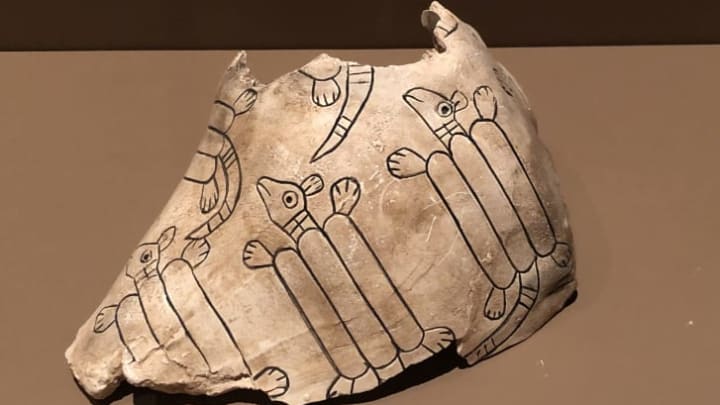
The Caddoan-speaking inhabitants of this Mississippian mound city along the Arkansas River built a thriving trade network from the Rocky Mountains to the Gulf Coast between 850 and 1450 CE. The culture’s most valued objects, conch shells, were imported from the Caribbean—the community even had an agent stationed in southern Florida to direct the shipments. The Craig Mound, a burial mound 350 feet long, 11 feet wide, and 34 feet tall, once held the remains of more than 1000 leaders, covered in earth and grave goods. The abundance of stone, copper, shell, and textile artifacts—looted before Oklahoma protected the mounds by law—prompted the Kansas City Star to call the burial mound the “King Tut of the Arkansas Valley.”
3. Serpent Mound // Ohio
There are no burials in the impressive Serpent Mound, located about 70 miles east of Cincinnati, Ohio. The 1348-foot-long earthwork, built on an ancient asteroid impact crater, is an effigy mound (a mound in the shape of an animal), and contained no artifacts to indicate when and by whom it was created. Some archaeologists believed the Serpent Mound was made by people of the Adena Culture, sometime between 800 BCE and 100 CE, because two Adena burial mounds are nearby. In 1991, an excavation of the Serpent Mound turned up charcoal bits that dated to a period between 1025 and 1215 CE, suggesting it was built by the Fort Ancient Culture, which lived in present-day Ohio between 1000 and 1650 CE.
4. Kolomoki Mounds State Park // Georgia
This mound complex in southwest Georgia is the region’s largest site built by people of the Woodland Period, an archaeological era lasting from 1000 BCE to 900 CE. At the height of its development, between 350 and 600 AD, the Kolomoki settlement was likely centered around eight earthen mounds, seven of which survive today and include a 57-foot-tall platform mound believed to have been used for ceremonies. Two of the mounds served as burial sites and contained large caches of animal-shaped pottery, while other excavations yielded shells and items that indicated a well-oiled trade network. In 1974, burglars broke into the site’s museum and stole 129 priceless ceramic artifacts—most of which are still missing—in the state’s most infamous art theft.
5. Effigy Mounds National Monument // Iowa
Between 600 and 1250 CE, in the Late Woodland Period, a culture known as the Effigy Moundbuilders constructed earthworks in the shapes of deer, bison, bear, and other wildlife in the upper Mississippi River valley. Effigy Mounds National Monument, along the Mississippi River south of the Iowa-Minnesota border, encompasses more than 200 effigy mounds, conical burial mounds, and rectangular platform mounds. Descendants of the builders, who belong to 20 culturally associated Native American tribes, suggest the mounds serve ceremonial and sacred purposes.
6. Caddo Mounds State Historic Site // Texas

A group of Mississippian Caddo people called the Hasinai settled this site, about 150 miles southeast of downtown Dallas, around 800 CE. The floodplain provided good soil for farming and the network of rivers allowed the Hasinai to obtain goods from far and wide, such as shells from present-day Florida and copper from the Great Lakes region. The site was largely abandoned in around 1300 CE, but three large mounds remain today at Caddo Mounds State Historic Site: the High Temple Mound, originally 35 feet high; the smaller Low Platform Mound; and the burial mound [PDF]. Excavation of the burial mound beginning in 1939 revealed about 90 bodies in 30 burial caches, along with sophisticated artifacts that hinted at the interred people’s high social status.
7. Etowah Indian Mounds State Historic Site // Georgia
The most intact Mississippian Culture site in the Southeast, Etowah Mounds State Historic Site comprises six mounds, a village site, a central plaza, and other structures that demonstrate the complex society that lived there between 1000 and 1500 CE. Two impressive flat-topped mounds may have been the sites of the chiefs’ houses and temples. An excavated and reconstructed burial mound yielded remains of 350 people and archaeological clues about the culture’s customs and social hierarchy [PDF]. An onsite museum displays many of the grave goods, including two large marble effigies of a man and a woman that were likely used in ceremonies.
8. Hopewell Culture National Historical Park // Ohio
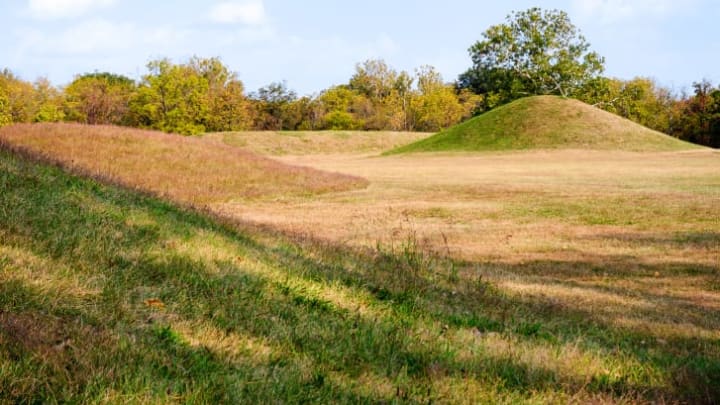
This collection of six major mound complexes outside modern-day Chillicothe, Ohio, illustrates the engineering prowess of the Hopewell Culture, which lived in the region as early as 100 BCE. The huge, geometrically shaped earthworks include square or circular enclosures around conical or rectangular mounds, all of which were used for ceremonial or mortuary purposes rather than as village sites. The Hopewell Mound Group, one of the park’s six areas, contains 29 cremation and burial mounds, such as one originally measuring 500 feet long and 33 feet tall. Like the later Woodland and Mississippian cultures, Hopewell people carried on trade with far-flung communities as evidenced by their finely wrought pottery, effigy pipes, and ornaments in silver, pearl, quartz, mica, obsidian, and other materials.
9. Bynum and Pharr Mounds // Mississippi

The Bynum Mounds, which originally numbered six, were built between 100 BCE and 100 CE by people of the Middle Woodland Period. They lie toward the southern end of the Natchez Trace, an ancient path stretching more than 400 miles from Natchez, Mississippi, to Nashville, Tennessee. In the 1940s, archaeologists discovered the grave of a woman, who had been buried with copper objects, in one of the mounds; another mound held the remains of several people along with greenstone ax-heads, copper spools, and projectile points (both of these mounds have been rebuilt). The Bynum Mounds are not far from another Middle Woodland Period complex along the Natchez Trace: the Pharr Mounds, dating to the 1st or 2nd century CE, and consisting of eight burial mounds. Four were excavated in the 1960s and found to contain human remains on low clay platforms, surrounded by grave goods.
10. Moundville Archaeological Park // Alabama
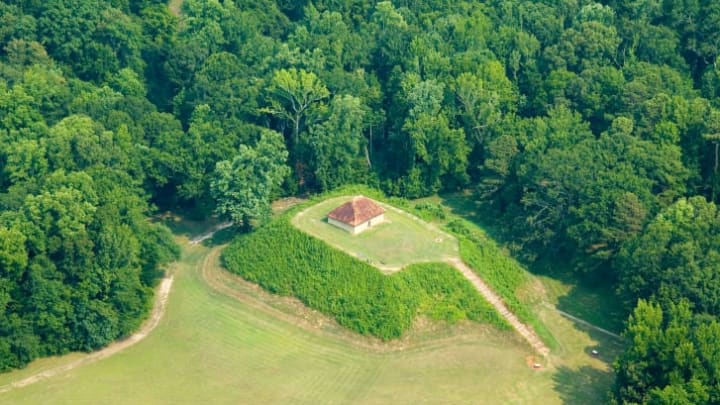
Second in size only to Cahokia, the Moundville site in west-central Alabama spanned 300 acres on the Black Warrior River. Like other Mississippian Culture settlements, the residents of this city practiced agriculture, developed trading relationships with other river communities, and built mounds to serve as ceremonial spaces and mortuary sites. Moundville’s village, plaza, and 26 mounds were encircled by a wooden palisade. Historians aren’t sure why the settlement began to decline after 1350 CE, but almost all inhabitants had abandoned the city by 1500 CE. Moundville Archaeological Park is but one stop on the Alabama Indigenous Mound Trail, an itinerary of 13 sites across the state that preserve and interpret pre-contact culture.
11. Poverty Point World Heritage Site // Louisiana
Designated a UNESCO World Heritage Site in 2014, Poverty Point in the northeastern corner of Louisiana preserves an array of incredibly old earthworks. Between 1700 and 1100 BCE, workers built a complex of six enormous, concentric, C-shaped ridges about 5 feet tall, segmented by walkways, which may have been foundations for dwellings. Archaeologists estimate that workers had to carry about 53 million cubic feet of soil in hand-held baskets to construct the amphitheater-like ridges. Six large mounds and caches of beads, figurines, tools, and other objects made of stone from sources hundreds of miles away demonstrate the community’s sophistication. But it’s unclear who built the earthworks, or why they were made—to date, archaeologists have not uncovered any ancient burials at Poverty Point.
![]()
